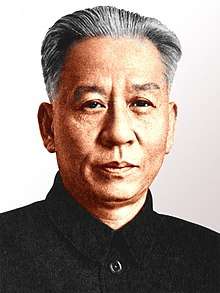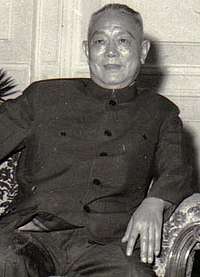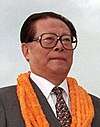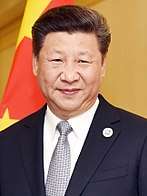President of the People's Republic of China
The president of the People's Republic of China is the head of state of the People's Republic of China. Under the country's constitution, the presidency is a largely ceremonial office with limited power. However, since 1993, as a matter of convention, the presidency has been held simultaneously by the general secretary of the Communist Party of China, the top leader in the one party system. The presidency is officially regarded as an institution of the state rather than an administrative post; theoretically, the president serves at the pleasure of the National People's Congress, the legislature, and is not legally vested to take executive action on his own prerogative.[note 1] The current president is Xi Jinping, who took office in March 2013.
| President of the People's Republic of China
中华人民共和国主席 | |
|---|---|
.svg.png) Emblem of the People's Republic of China | |
 | |
| Style | Mr. / Madam President (主席) (formal) His / Her Excellency (阁下) (in international correspondence) |
| Status | Head of state |
| Residence | Zhongnanhai |
| Seat | West Building, Zhongnanhai, Beijing (de jure) |
| Nominator | Presidium of the National People's Congress |
| Appointer | National People's Congress |
| Term length | Five years Renewable; No term limits |
| Constituting instrument | Constitution of the People's Republic of China |
| Inaugural holder | Mao Zedong (as Chairman under the 1954 Constitution) Li Xiannian (as President under the 1982 Constitution) |
| Formation | 27 September 1954 18 June 1983 |
| Abolished | January 1975 – December 1982 |
| Deputy | Vice President |
| Salary | ¥152,121 RMB ($22,000 USD)[1] |
| Website | Presidency |
| President of the People's Republic of China | |||||||||||
|---|---|---|---|---|---|---|---|---|---|---|---|
| Simplified Chinese | 中华人民共和国主席 | ||||||||||
| Traditional Chinese | 中華人民共和國主席 | ||||||||||
| Literal meaning | Chinese People Republic Chairperson | ||||||||||
| |||||||||||
| Alternative Chinese name | |||||||||||
| Simplified Chinese | 国家主席 | ||||||||||
| Traditional Chinese | 國家主席 | ||||||||||
| Literal meaning | State Chairperson | ||||||||||
| |||||||||||
Since 1993, apart from brief periods of transition, the top leader of China simultaneously serves as the president, the leader of the party (as General Secretary), and the commander-in-chief of the military (as the chairman of the Central Military Commission). This individual then carries out different duties under separate titles. For example, the leader meets foreign dignitaries and receives ambassadors in his capacity as President, issues military directives as Chairman of the Central Military Commission, and upholds party rule as the general secretary of the Communist Party of China.
The presidency was first established in the Constitution of the People's Republic of China in 1954 and successively held by Mao Zedong and Liu Shaoqi. Liu fell into political disgrace during the Cultural Revolution, after which the presidency became vacant. The presidency was abolished under the Constitution of 1975, then reinstated in the Constitution of 1982, but with reduced powers. The official English-language translation of the title was "Chairman"; after 1982, this translation was changed to "President", although the Chinese title remains unchanged.[note 2]
Between 1982 and 2018, the constitution stipulated that the president could not serve more than two consecutive terms. During the Mao era and also since 2018, there were no term limits attached to this office. In 2018, the term limits of the presidency was abolished, but its powers and ceremonial role were unchanged.
Qualifications and election
According to the current Constitution of the People's Republic of China, the president must be a Chinese citizen with full electoral rights who has reached the age of 45.
The president is elected by the National People's Congress (NPC), China's highest state body, which also has the power to remove the president and other state officers from office. Elections and removals are decided by a simple majority vote.[2]
According to the Organic Law of the NPC, the president is nominated by the NPC Presidium, the Congress's executive organ.[3] In practice, however, the ruling Communist Party of China reserves the post of president for its current general secretary. Like all officers of state elected by the NPC, the president is elected from a one name ballot.
In the event that the office of president falls vacant, the vice-president succeeds to the office. In the event that both offices fall vacant, the president of the NPC Standing Committee temporarily acts as President until the NPC can elect a new president and vice-president.[4]
Between 1982 and March 2018, the president and vice-president were limited to two consecutive terms.[5] However these limits were removed at the 2018 National People's Congress.[6][7]
Powers and duties
Under the current constitution, instated in 1982 with minor revisions in later years, the president has the power to promulgate laws, select and dismiss the premier (prime minister) as well as the ministers of the State Council, grant presidential pardons, declares a state of emergency, issue mass mobilization orders, and issue state honours. In addition, the president names and dismisses ambassadors to foreign countries, signs and annuls treaties with foreign entities. According to the Constitution, all of these powers require the approval or confirmation of the National People's Congress. The president also conducts state visits on behalf of the People's Republic. Under the constitution the "state visit" clause is the only presidential power that does not stipulate any form of oversight from the National People's Congress. As the vast majority of presidential powers are dependent on the ratification of the NPC, the president is, in essence, a symbolic post without any direct say in the governance of state. It is therefore conceived to mainly function as an symbolic institution of the state rather than an office with true executive powers.[8][5][9]
In theory, the president has discretion over the selection of the premier, though in practice the premier has historically been selected through the top-level discussions of the Communist Party of China. Upon the nomination of the premier, the NPC convenes to confirm the nomination, but since only one name is on the ballot, it can only approve or reject. To date, it has never rejected a personnel nomination.[10] Since the premier, the head of government in China, is the most important political appointment in the Chinese government, the nomination power, under some circumstances, may give the president real political influence.[11]
In 2019, a report of U.S.-China Economic and Security Review Commission said that everyone should stop calling Chinese leader Xi Jinping “President” instead of “General Secretary” under Xi’s one-party leadership.[12]
The president also has multiple modes of transports which he/she controls and can alter at any time.
By plane
The history of transporting heads of state dates back to the time of CAAC Airlines.
Lower officials would be transported in a CAAC Boeing 707. Chairman Mao Zedong had a personal Ilyushin Il-18 which he used on his visits. After he died, the aircraft was withdrawn from service and preserved at an aviation museum in China. In the 1970s, the position of Chinese president was abolished, but Mao Zedong and Hua Guofeng were Chairman of the Communist Party of China successively. With the introduction of the Boeing 747, officials started using the CAAC Boeing 747SP for international trips. After the CAAC was split up into six in 1988, the 747s were handed over to Air China, and officials continued using 747SPs under the CA livery.
When Jiang Zemin came into power and succeeded as Party General Secretary in 1989, the 747SPs were permanently returned to passenger service, and 747-400s were utilized. They were used throughout the use of Jiang, Hu Jintao and Xi Jinping. The 747-400s originally belong to Air China, but one month before the president goes on an official trip, the chosen plane is specifically inspected and retrofitted for VIP use. After the president returns to Beijing, the 747-400 is inspected and converted back to passenger configurations.
In the 2010s a Boeing 747-8 painted in the CA livery was seen around the world, under the fake rego B-2479 and the real rego B-2485. Rumours spread, saying this would be China's new Air Force One. In 2016 it was seen landing in Hamburg for VIP configuration, and since then, it has been on loan to the Chinese Government from Air China for use by the president. Although no official photos have been released, the inside is thought to have a far more lavish interior, including conference tables, seating for the press, private bedrooms, and other features.
After the 747-8 was introduced, the 747-400s now carry ministers and serve as decoy aircraft. On some occasions, an Air China Boeing 737 has even been used for transport. In the late 2010s, the president started importing his own presidential car on foreign trips. For this reason, an Air China Boeing 747 cargo aircraft is used for transportation of freight.
In order not to confuse air traffic control between a normal CA flight and a flight carrying a Chinese government member, all aircraft carrying government people fly under the callsign CA1 to CA100, since normal CA flights fly under the callsign CA101 and above.
Political ranking
For President Liu Shaoqi, he was also the first vice chairman of the Communist Party of China, ranked second in the Communist Party of China, behind Chairman Mao Zedong.[13] For President Li Xiannian, he was also the 5th ranked member of the Politburo Standing Committee, after CPC general secretary and premier.[14] For President Yang Shangkun, he was not a member of Politburo Standing Committee, but he ranked third after General Secretary Zhao Ziyang and Deng Xiaoping.[15] Since Jiang Zemin, the president is also the general secretary of the Communist Party of China, ranking first in party and state.[16]
History
Establishment in 1954
The office of State Chairman (the original English translation, as noted above) was first established under the 1954 Constitution. The ceremonial powers of the office were largely identical to those in the current Constitution.[17]
The powers of the 1954 office differed from those of the current office in two areas: military and governmental. The state chairman's military powers were defined in the 1954 Constitution as follows: "The Chairman of the People's Republic of China commands the armed forces of the state, and is Chairman of the National Defence Council (Chinese: 国防委员会)."[18] The National Defence Council was unique to the 1954 Constitution, and was mandated as the civil command for the People's Liberation Army. It was abolished under the 1975 Constitution.
The state chairman's governmental powers were defined in the 1954 Constitution as follows: "The Chairman of the People's Republic of China, whenever necessary, convenes a Supreme State Conference (Chinese: 最高国务会议) and acts as its chairman." The members of the Supreme State Conference included the main officers of state, and its views were to be presented to the main organs of state and government, including the National People's Congress and the State and National Defense Councils.[19] The Supreme State Conference was also unique to the 1954 Constitution. It was abolished under the 1975 Constitution and later Constitutions have not included a similar body.
History up to 1974
Mao Zedong was the first to hold the office of State Chairman. He was elected at the founding session of the National People's Congress in 1955. At the 2nd NPC in 1959, Mao was succeeded by Liu Shaoqi, first vice chairman of the Communist Party. Liu was reelected as State Chairman at the 3rd NPC in Jan 1965. However, in 1966, Mao launched the Cultural Revolution and by August 1966 Mao and his supporters succeeding in removing Liu from his position as party vice chairman. A few months later Liu was apparently placed under house arrest, and after a prolonged power struggle the 12th Plenum of the 8th Communist Party Congress stripped Liu Shaoqi of all his party and non-party positions on 31 October 1968, including the post of State Chairman. This was in violation of the Constitution, which required a vote by the NPC to remove the state chairman.
After Liu's removal in 1968, the office of State Chairman was vacant. From 1972 to 1975, however, state media referred to Vice State Chairman Dong Biwu as "acting state chairman."
Abolition in 1975
When the 4th NPC was convened in 1975, its main act was to adopt a new Constitution which eliminated the office of State Chairman and emphasized instead the leadership of the Communist Party over the state, including an article that made the party chairman Supreme Commander of the PLA in concurrence as Chairman of the party CMC.[20] The 5th NPC was convened two years early, in 1978, and a third Constitution was adopted, which also lacked the office of State Chairman. The office was finally reinstated in the fourth Constitution, adopted by the 5th Session of the 5th NPC in 1982. The title of the office (国家主席, guojia zhuxi) was unchanged in the Chinese text, but a new English translation of "President of the People's Republic of China" was adopted.
Restoration in 1982
In the 1982 Constitution, the president was conceived of as a figurehead of state with actual state power resting in the hands of the general secretary of the Communist Party, premier of the State Council and the chairman of the Central Military Commission, and all four posts were designed to be held by separate people. The president therefore held minor responsibilities such as greeting foreign dignitaries and signing the appointment of embassy staff, and did not intervene in the affairs of the State Council or the party. In the original 1982 Constitution plan, the party would develop policy, the state would execute it, and the power would be divided to prevent a cult of personality from forming as it did with the case of Mao Zedong. Thus in 1982, China perceivably had four main leaders: Hu Yaobang, the party general secretary; Zhao Ziyang, the premier; Li Xiannian, the president; and Deng Xiaoping, the "paramount leader", holding title of the chairman of the Central Military Commission and was overall commander-in-chief of the armed forces. The current political structure of Vietnam is similar to the structure China followed in the 1980s.
In the 1990s, the experiment of separating party and state posts, which led to conflict during the Tiananmen Square protests of 1989, was terminated. In 1993, the post of President was taken by Jiang Zemin, who as General Secretary of the Communist Party and Chairman of the Central Military Commission, became the undisputed top leader of the party and the state.[21][22] When Jiang Zemin stepped down in 2003, the offices of General Secretary and President were once again both given to one man, then–Vice-President Hu Jintao, the first vice-president to assume the office. In turn, Hu vacated both offices for Xi Jinping in 2012 and 2013.[23] Under Xi, the term limits for the president were removed.[7]On March 11th 2018, the National People's Congress of China, which voted 2,958 in favor, two opposed and three abstaining, pass The Amendment of The Constitution of the People’s Republic of China. The Amendment changes the country's constitution abolishing term limits of President and vice President of the People’s Republic of China. This was widely interpreted as part of an expansion of Xi's power, effectively extending his tenure as China's paramount leader indefinitely.[7] Xi explained the decision in terms of needing to align two more powerful posts — General Secretary of the Communist Party and Chairman of the Central Military Commission which are no term limits.[24]
List of heads of state
Timeline
Chairmen/presidents
Other heads of state
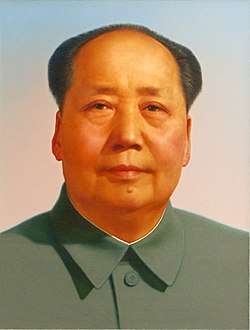 Mao Zedong
Mao Zedong
Chairman of the Central People's Government (1949-1954) Zhu De
Zhu De
Chairman of the Standing Committee of the National People's Congress (1975–1976) Song Qingling
Song Qingling
Acting Chairwoman of the Standing Committee of the National People's Congress (1976–1978)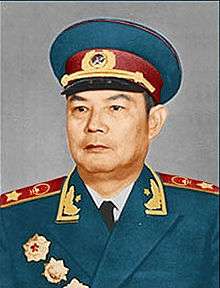 Ye Jianying
Ye Jianying
Chairman of the Standing Committee of the National People's Congress (1978–1983)
Statistics
| # | President | Date of birth | Age at ascension (first term) |
Time in office (total) |
Age at retirement (last term) |
Date of death | Longevity |
|---|---|---|---|---|---|---|---|
| 1 | Mao Zedong | 26 December 1893 | 60 years, 275 days | 4 years, 212 days | 64 years, 122 days | 9 September 1976 | 82 years, 258 days |
| 2 | Liu Shaoqi | 24 November 1898 | 60 years, 154 days | 9 years, 187 days | 69 years, 342 days | 12 November 1969 | 70 years, 353 days |
| Presidency vacant | |||||||
| acting | Dong Biwu | 5 March 1886 | 85 years, 356 days | 2 years, 327 days | 88 years, 318 days | 2 April 1975 | 89 years, 28 days |
| acting | Soong Ching-ling | 27 January 1893 | 83 years, 161 days | 1 year, 242 days | 85 years, 37 days | 29 May 1981 | 88 years, 122 days |
| Presidency abolished | |||||||
| 3 | Li Xiannian | 23 June 1909 | 73 years, 360 days | 4 years, 295 days | 78 years, 290 days | 21 June 1992 | 82 years, 364 days |
| 4 | Yang Shangkun | 3 August 1907 | 80 years, 250 days | 4 years, 352 days | 85 years, 236 days | 14 September 1998 | 91 years, 42 days |
| 5 | Jiang Zemin | 17 August 1926 | 66 years, 222 days | 9 years, 353 days | 76 years, 210 days | Living | 93 years, 365 days (Living) |
| 6 | Hu Jintao | 21 December 1942 | 60 years, 84 days | 10 years, 0 days | 70 years, 84 days | Living | 77 years, 239 days (Living) |
| 7 | Xi Jinping | 15 June 1953 | 59 years, 272 days | 7 years, 155 days (Ongoing) | Incumbent | Living | 67 years, 62 days (Living) |
President's spouse
Since the first president, seven had a spouse during term of office.
| № | Spouse | President | Tenure |
|---|---|---|---|
| 1 | Jiang Qing | Mao Zedong | 1 October 1949 – 27 April 1959 |
| 2 | Wang Guangmei | Liu Shaoqi | 27 April 1959 – 31 October 1968 |
| 3 | Lin Jiamei | Li Xiannian | 18 June 1983 – 8 April 1988 |
| 4 | Li Bozhao | Yang Shangkun | 8 April 1988 – 27 March 1993 |
| 5 | Wang Yeping | Jiang Zemin | 27 March 1993 – 15 March 2003 |
| 6 | Liu Yongqing | Hu Jintao | 15 March 2003 – 14 March 2013 |
| 7 | Peng Liyuan | Xi Jinping | 14 March 2013 – Incumbent |
See also
- Air transports of heads of state and government
- List of Chinese leaders
- List of leaders of the People's Republic of China
- Paramount leader
- Political position ranking of the People's Republic of China
- Premier of the People's Republic of China
- Vice President of the People's Republic of China
- President of the Republic of China
Notes
- The presidency is listed as such in the current Constitution; it is thus equivalent to organs such as the State Council, rather than to offices such as that of the Premier.
- In Chinese the President of the PRC is termed zhǔxí while the Presidents of other countries are termed zǒngtǒng. Furthermore zhǔxí continues to have the meaning of "chairman" in a generic context.
References
- "Public employees get salary increase - China - Chinadaily.com.cn". www.chinadaily.com.cn. Archived from the original on 5 June 2019. Retrieved 4 November 2019.
- Constitution of the People's Republic of China Archived 12 August 2010 at the Wayback Machine, Articles 62, 63.
- "Organic Law of the National People's Congress of the PRC". Archived from the original on 15 July 2015. Retrieved 3 July 2013., Article 13.
- Constitution of the People's Republic of China Archived 12 August 2010 at the Wayback Machine, Article 84.
- Krishna Kanta Handique State Open University Archived 2 May 2014 at the Wayback Machine, EXECUTIVE: THE PRESIDENT OF THE CHINESE REPUBLIC.
- "CPC proposes change on Chinese president's term in Constitution - Xinhua - English.news.cn". www.xinhuanet.com. Xinhua. 25 February 2018. Archived from the original on 25 October 2018. Retrieved 25 February 2018.
- "China approves 'president for life' change". BBC News. 11 March 2018. Archived from the original on 11 March 2018. Retrieved 11 March 2018.
- Chris Buckley and Adam Wu (10 March 2018). "Ending Term Limits for China's Xi Is a Big Deal. Here's Why. - Is the presidency powerful in China?". New York Times. Archived from the original on 12 March 2018. Retrieved 12 March 2018.
In China, the political job that matters most is the General Secretary of the Communist Party. The party controls the military and domestic security forces, and sets the policies that the government carries out. China’s presidency lacks the authority of the American and French presidencies.
CS1 maint: uses authors parameter (link) - Constitution of the People's Republic of China Archived 12 August 2010 at the Wayback Machine, Article 62, Section 5. The NPC does no itself have the power to nominate the Premier.
- Yew, Chiew Ping; Gang Chen (13 March 2010). China's National People's Congress 2010: Addressing Challenges With No Breakthrough in Legislative Assertiveness (PDF). Background Brief. Singapore: East Asian Institute. Archived from the original (PDF) on 23 September 2015. Retrieved 3 July 2013.
- Weng, Byron (September 1982). "Some Key Aspects of the 1982 Draft Constitution of the People's Republic of China". The China Quarterly (91): 492–506. JSTOR 653370.
- Kate O’Keeffe and Katy Stech Ferek (14 November 2019). "Stop Calling China's Xi Jinping 'President,' U.S. Panel Says". The Wall Street Journal. Archived from the original on 15 November 2019. Retrieved 16 November 2019..
- Mathews, Jay (4 March 1980). "5 Children of Liu Shaoqi Detail Years in Disfavor". Washington Post. Archived from the original on 29 April 2018. Retrieved 12 March 2018.
- "Li Xiannian: China's new president". UPI. 18 June 1983. Archived from the original on 12 March 2018. Retrieved 12 March 2018.
- Del Vecchio, Mark S. "Yang Shangkun elected Chinese president". UPI. Archived from the original on 12 March 2018. Retrieved 12 March 2018.
- "Jiang Zemin to have lower rank in Communist party". The Telegraph. 2013. Archived from the original on 12 March 2018. Retrieved 12 March 2018.
- Constitution of the People's Republic of China, 1954 Archived 1 June 2014 at the Wayback Machine, Articles 40–42.
- Constitution of the People's Republic of China Archived 1 June 2014 at the Wayback Machine, Article 43.
- Constitution of the People's Republic of China Archived 1 June 2014 at the Wayback Machine, Article 44.
- Cohen, Jerome Alan (1 December 1978). "China's Changing Constitution". The China Quarterly (76): 794–841. ISSN 0305-7410. JSTOR 652647.
- "A simple guide to the Chinese government". South China Morning Post. Archived from the original on 13 May 2018. Retrieved 12 May 2018.
Xi Jinping is the most powerful figure in the Chinese political system. He is the President of China, but his real influence comes from his position as the General Secretary of the Chinese Communist Party.
- "China sets stage for Xi to stay in office indefinitely". Reuters. 25 February 2018. Archived from the original on 26 February 2018. Retrieved 26 February 2018.
However, the role of party chief is more senior than that of president. At some point, Xi could be given a party position that also enables him to stay on as long as he likes.
- "Does Chinese leader Xi Jinping plan to hang on to power for more than 10 years?". 6 October 2017. Archived from the original on 7 October 2017. Retrieved 7 October 2017.
If Xi relinquished the presidency in 2023 but remained party chief and chairman of the Central Military commission (CMC), his successor as president would be nothing more than a symbolic figure... “Once the president is neither the party’s general secretary nor the CMC chairman, he or she will be hollowed out, just like a body without a soul.”
- Mitchell, Tom. "China's Xi Jinping says he is opposed to life-long rule". Financial Times. Archived from the original on 17 April 2018. Retrieved 17 April 2018.
President insists term extension is necessary to align government and party posts
External links
- The President's official website (in English)

